
漢德百科全書 | 汉德百科全书
 Croatia
Croatia

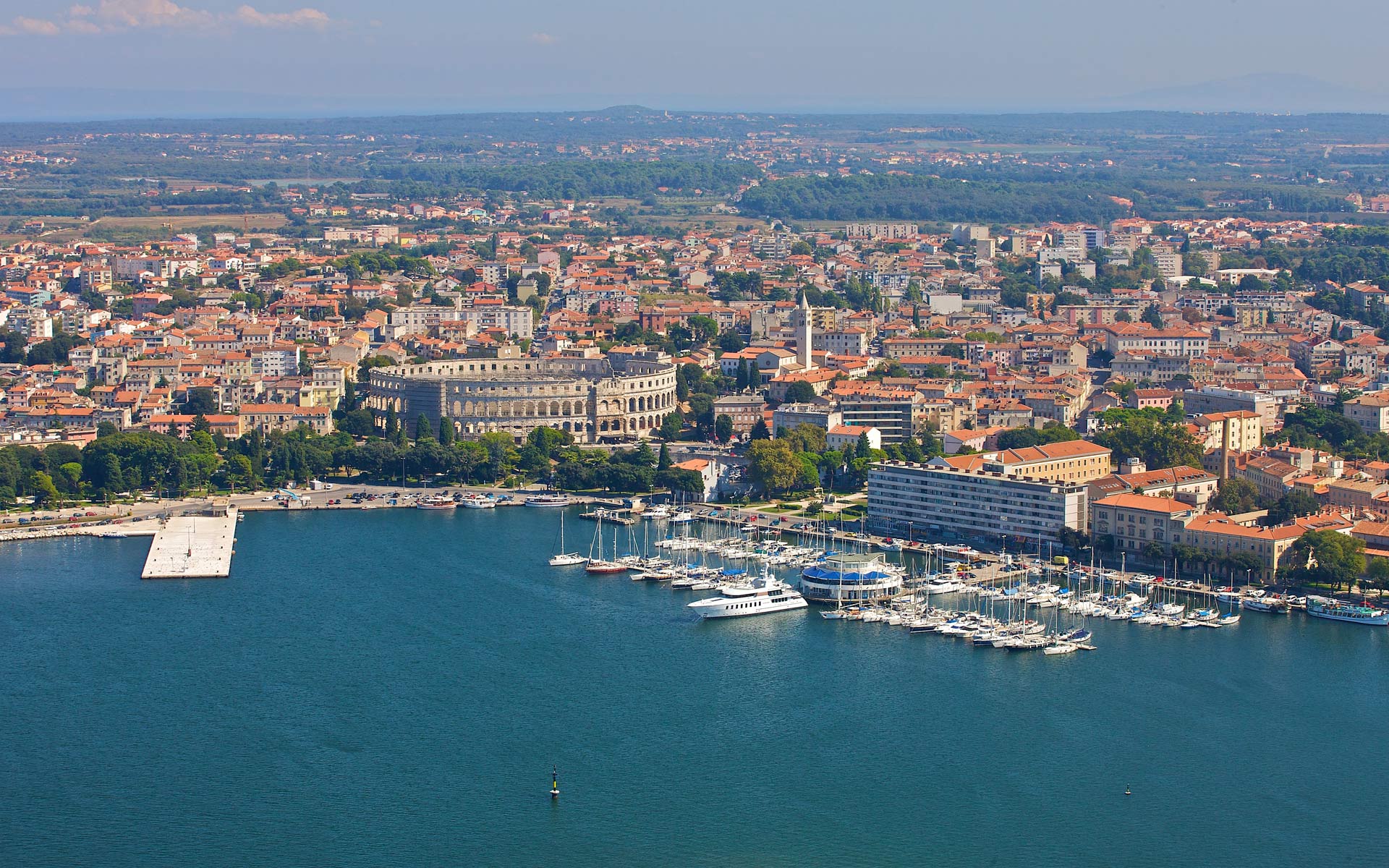
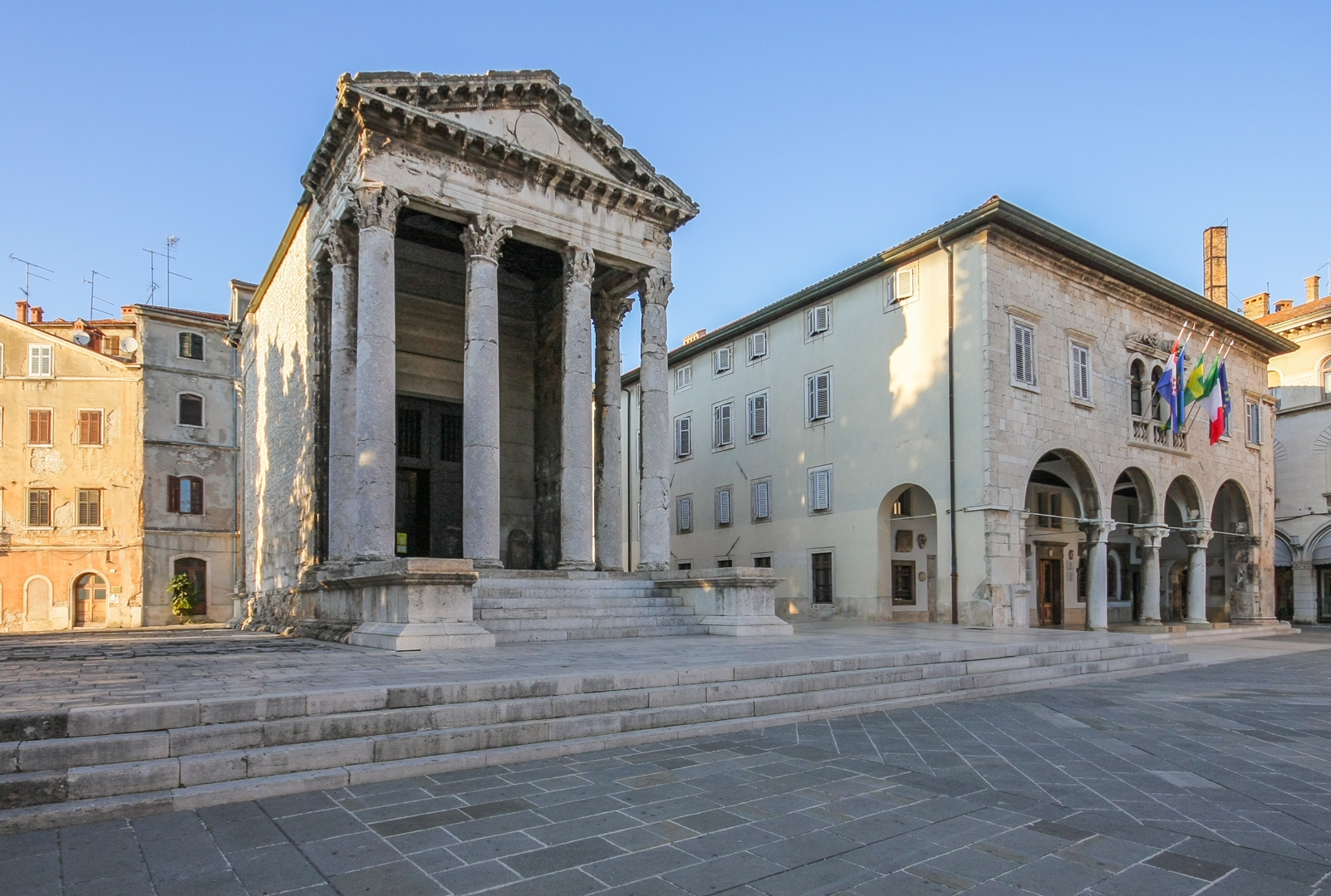
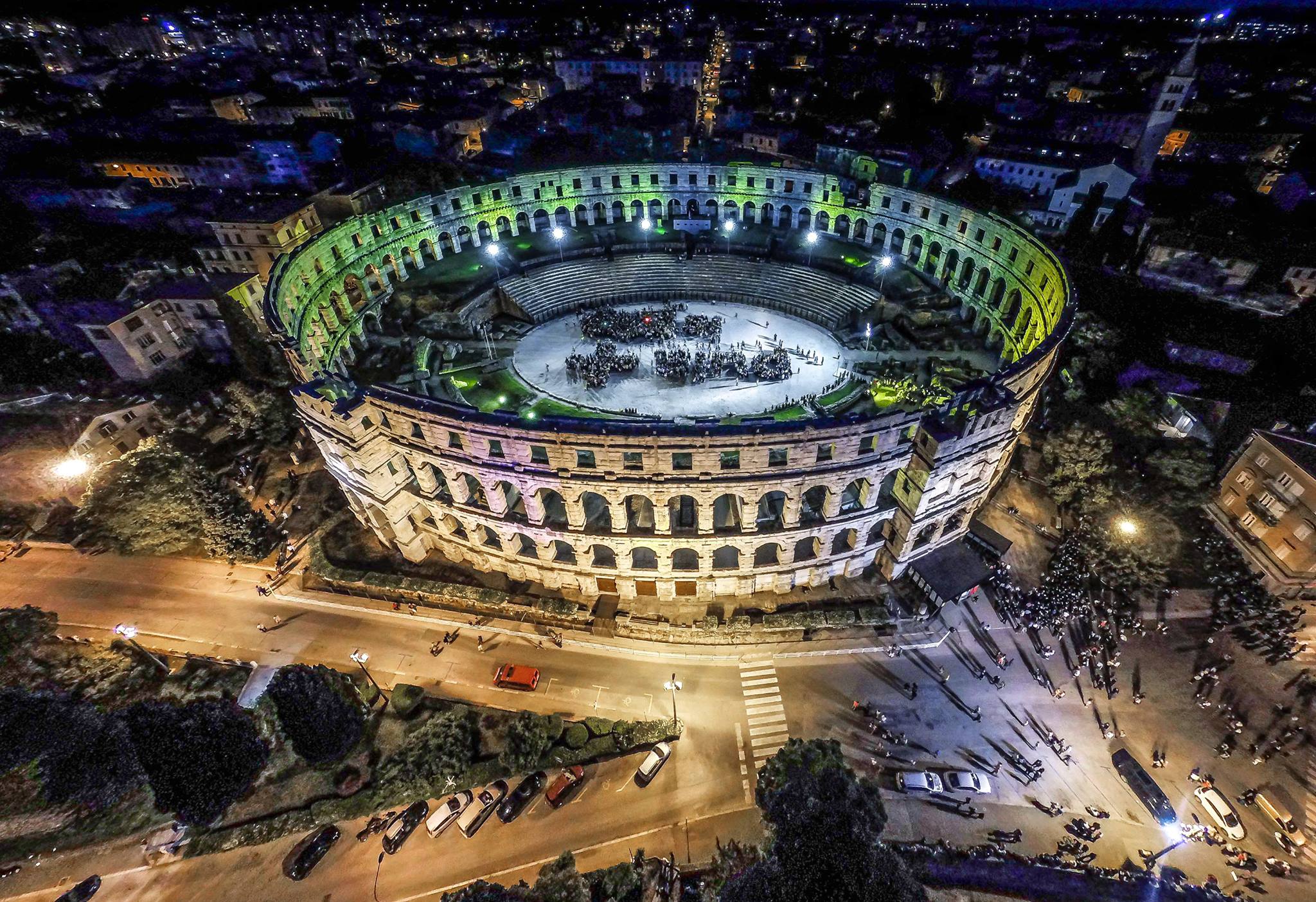
Das römische Amphitheater in Pula (Kroatien) (kroatisch: Pulska Arena) ist das sechstgrößte antike Amphitheater.[1] Im Endausbau (seit 81 n. Chr.) bestand es aus zwei übereinander angeordneten Arkadenreihen mit 72 Bögen aus weißem Kalkstein. Das Obergeschoss ist von 64 rechteckigen Fensternischen durchbrochen. Das Gebäude erreichte meerseitig eine Höhe von 32,45 Metern. Da sich der Bau im Osten an einen Hügel lehnt, ist die Fassade dort wesentlich niedriger und in der unteren Bogenreihe sind 32 Bögen als Anpassung an das Gelände teilweise oder ganz weggelassen worden. Im Inneren folgten die Sitzreihen der Hanglage. Damit bot es Platz für 26.000 Zuschauer.[1] In der Antike diente die Arena für Gladiatorenkämpfe und zeitweise für die Darstellung von Naumachien, also Seeschlachten.
Im Untergeschoss des Theaters zeigt ein Museum die Geschichte des Weinbaus in römischer Zeit. Auch die Stile und Verwendungen von Amphoren und die antiken Handelsbeziehungen Istriens werden dargestellt.
普拉竞技场(克罗地亚语:Amfiteatar u Puli)是位于克罗地亚西北部伊斯特拉半岛城市普拉的一座古罗马时期的圆形竞技场[1]。现在则是音乐会和电影节的会场。普拉竞技场修建于罗马帝国首任皇帝奥古斯都在位时期。
プーラ円形闘技場(クロアチア語: Amfiteatar u Puli,英語: Amphitheatre of Pula)またはプーラ・アレナ(Pulska Arena,Pula Arena)は、クロアチア北西部のイストリア半島先端のプーラにある古代ローマ時代に造られた円形闘技場。
古代ローマ時代には剣闘士の戦いや剣闘士と猛獣の戦いなどの見世物が、中世には騎士の模擬戦争が行われた[1]。現在はコンサートや映画祭等の会場[1]として用いるため、陸側の下層階客席などが復元されている。また剣闘士の戦いのショー[1]が行われることもある。
この闘技場はローマ帝国初代皇帝アウグストゥス(在位 前27年 - 14年)[2]から第9代皇帝ウェスパシアヌス(在位 69年 - 79年)[1]の治世のころ、中央政府の予算にて建設されたと考えられている。建物はアドリア海に向かって傾斜する斜面に建てられていて、長辺132.5m、短辺105.1mの楕円形で敷地面積11,466m2であり[2]、中央の平らな競技スペース(アレナ)も67.9m×41.6mの楕円形である。また、地上からの高さは海側の最も高い所で32.45mである[2]。客席部分の建物は、海側において地上から嵩上げに使われた壁の外観を呈する1階部分と、アーチ構造のファサードを持つ2階から4階となっており、総観客数23,000人を収容できた[2]と考えられている。なお、コンサート会場等として改修された現在の観客収容数は約5,000人である[1]。
楕円の長辺の南側はプーラ旧市街方向を向いており、わずかに大きな4m幅のアーチを持つ施設のメイン・ゲートとなっている。2階部分のアーチ窓は楕円の全周で72箇所あり、最上階の4階の長方形の窓は長辺・短辺端の4箇所の塔構造の部分を除いて全周で64箇所である[2]。
競技スペースの下には地階があり、出し物に使われる猛獣等を格納したり、資機材を保管するために使われていたと考えられている。現在、地階は出土品の展示スペースとなっている[3]。
5世紀頃には闘技場は使われなくなり[2]、その石材が他の建物の建築資材として持ち去られ、廃墟となっていった。
The Pula Arena (Croatian: Pulska Arena, Italian: Arena di Pola) is the name of the amphitheatre located in Pula, Croatia. The Arena is the only remaining Roman amphitheatre to have four side towers and with all three Roman architectural orders entirely preserved. It was constructed in 27 BC – 68 AD[1] and is among the six largest surviving Roman arenas in the World.[1] A rare example among the 200 surviving Roman amphitheatres, it is also the best preserved ancient monument in Croatia.
The amphitheatre is depicted on the reverse of the Croatian 10 kuna banknote, issued in 1993, 1995, 2001 and 2004.[2]
L'amphithéâtre de Pula est un amphithéâtre romain bien conservé, situé à Pula, en Istrie (Croatie).
Il fut construit au Ier siècle, sous le règne de l'empereur Auguste, puis fut reconstruit et agrandi par l'empereur Vespasien, en 79 apr. J.-C..
De nombreux combats de gladiateurs se déroulèrent dans son enceinte durant l'Antiquité. Au Moyen Âge, il fut utilisé pour divers combats, puis ses pierres furent en partie remployées dans d'autres édifices de la ville de Pula, notamment le château, au XVe siècle.
L’anfiteatro di Pola (chiamato anche Arena di Pola in croato: Pulska Arena) è per grandezza il sesto nel suo genere. Il suo nome deriva dal latino ărēna, che indica la sabbia che ricopriva le platee degli anfiteatri romani. Tra i polesi il monumento emblema della città, dal grandissimo valore simbolico ed affettivo, è chiamato solitamente Rena, dal dialetto istroveneto.
L'anfiteatro venne costruito tra il 2 a.C. ed il 14 d.C. sotto l'imperatore Augusto, prelevando il materiale dalle note cave di pietra situate alla periferia della città ed ancora oggi esistenti. In seguito, l'imperatore Vespasiano, che aveva commissionato il Colosseo a Roma, lo fece ampliare (secondo la leggenda, egli voleva rendere omaggio ad una sua amante del luogo).
Come il Colosseo, veniva utilizzato prevalentemente per combattimenti di gladiatori o per naumachie. Si presume che sia rimasto intatto, seppure in uno stato di sempre maggiore trascuratezza ed abbandono, fino al XV secolo. In seguito sarebbe stato saltuariamente utilizzato come cava di pietra per alcune costruzioni della Repubblica di Venezia, oltreché degli abitanti locali. Salì infatti all'onore delle cronache nel 1583 quando al Senato veneziano, versando Pola in uno stato di sempre maggior decadenza e desolazione, si propose di smontare l'Arena pezzo per pezzo e di ricostruirla a Venezia. A sventare tal proposito fu soprattutto l'azione del senatore veneziano Gabriele Emo e per questo suo impegno, nell'anno successivo la città di Pola pose su una torre dell'Arena, lato mare, una lapide a perenne memoria e gratitudine.
Fu oggetto di ampio restauro durante l'epoca napoleonica.
Viene utilizzato tutt'oggi, similmente all'Arena di Verona: è un ambito centro di teatro e musica e nel 1993 ha ospitato il festival di Pola e gli Histria festivals, oltre a una puntata di Giochi senza frontiere nel 1981[1]. Ogni estate è il palco privilegiato del Pola Film Festival. Personaggi di fama mondiale come Sting, Julio Iglesias, Anastacia, Luciano Pavarotti, Grace Jones, Norah Jones, Alanis Morissette, David Gilmour si sono esibiti in questa arena. Attualmente, è in grado di ospitare cinquemila spettatori.
El anfiteatro de Pula, también conocido como Pula Arena, es un anfiteatro romano ubicado en la ciudad croata de Pula. Se trata del único anfiteatro conservado que cuenta con cuatro torres y con los tres órdenes arquitectónicos clásicos perfectamente preservados en altura. Fue levantado entre el año 27 a. C. y el 81 d. C.1 y por sus dimensiones está entre los seis anfiteatros romanos más grandes que se pueden contemplar en la actualidad.1 Asimismo, es el edificio romano mejor conservado de toda Croacia, motivo por el que aparece representado en el reverso de los billetes de diez kuna desde el año 1993.2 El excelente estado de conservación de este edificio romano ha permitido estudiar a fondo las técnicas constructivas de la Antigua Roma. En la actualidad, el Pula Arena alberga la celebración de actuaciones musicales.
Levantado junto al mar, los muros exteriores están hechos de sillares regulares de piedra caliza. La fachada que da hacia el mar tiene tres pisos y una altura máxima que ronda los 30 m, mientras que el resto de su perímetro tan solo tiene dos alturas porque aprovecha el desnivel del terreno. Los dos primeros niveles presentan 72 arcos de medio punto cada uno, mientras que el último cuenta con 64 arcos adintelados.
El eje mayor de la planta elíptica del anfiteatro tiene 132,45 m y el menor 105,1 m. La cávea (gradas) pudo acomodar en origen a unos 23 000 espectadores en sus 40 escalones, apoyados en parte en la pendiente que baja hacia la costa. La arena del recinto tiene unas dimensiones de 67,95 m por 41,65 m y queda separada de la cávea por un murete en el que se abren quince puertas. Debajo de la arena existen una serie de pasillos y dependencias subterráneas que en origen se empleaban para cobijar a las fieras y los gladiadores que intervenían en los espectáculos. Bajo las gradas también existen diversas dependencias y almacenes.
Cada una de las cuatro torres tiene dos cisternas que se llenaban con agua perfumada, que se usaba tanto para abastecer una fuente como para rociar a los espectadores. Las gradas del anfiteatro podían cubrirse con velarii, unos grandes toldos que protegían a los asistentes del sol o la lluvia.
Амфитеа́тр Пу́лы — памятник древнеримской истории и архитектуры. Расположен в городе Пула, Хорватия. Это единственная из сохранившихся арен, которая имеет 4 башни и все три римских архитектурных ордера. При этом по своим размерам амфитеатр занимает 6-е место в мире среди подобных сооружений.
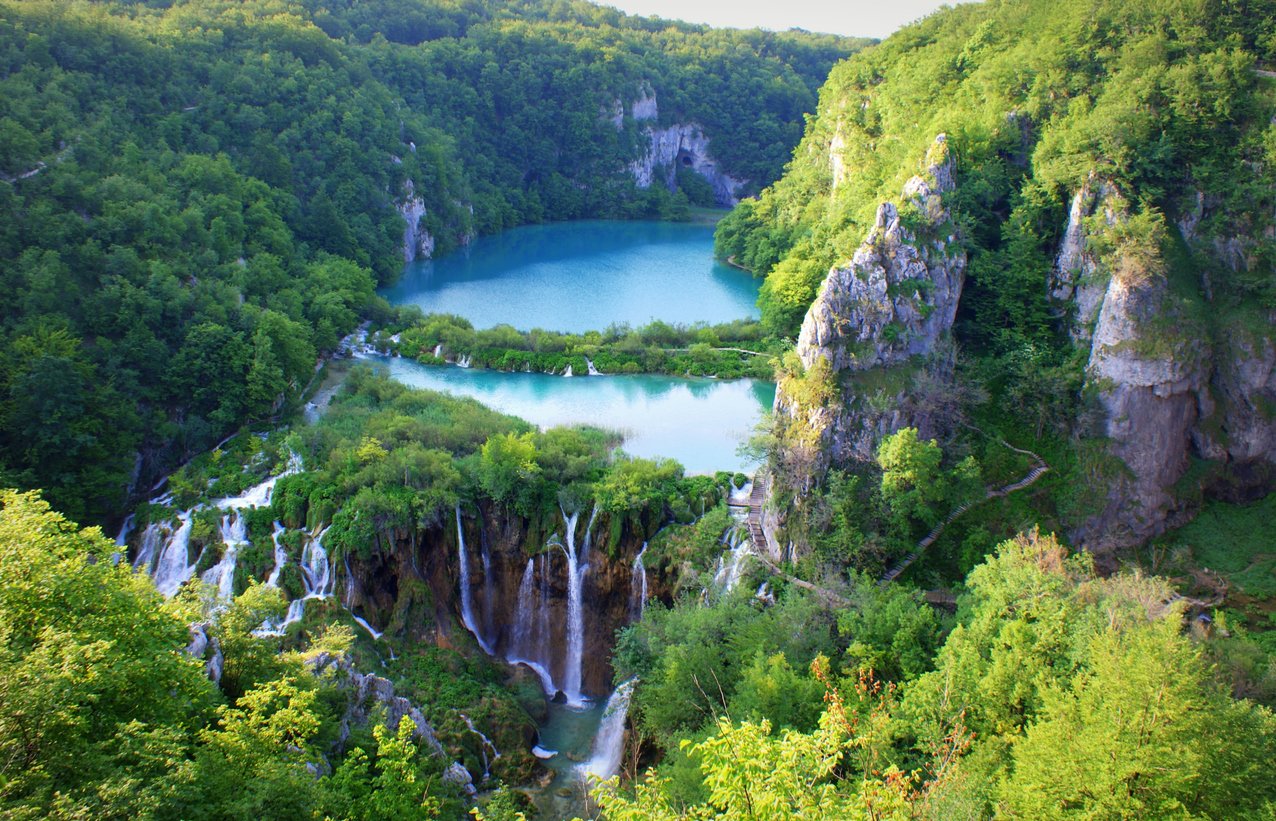
Der Nationalpark Plitvicer Seen [ˌplɪtvɪt͡sɐ ˈzeːən][2][3] (kroatisch Nacionalni park Plitvička jezera, umgangssprachlich Plitvice, dt. auch Plitwitzer Seen[4]) ist der flächenmäßig größte Nationalpark Kroatiens[5] und zugleich auch der älteste Nationalpark Südosteuropas. Er wurde 1949 gegründet und befindet sich im hügeligen Karstgebiet Mittelkroatiens unweit der Grenze zu Bosnien und Herzegowina, direkt an einer wichtigen Nord-Süd-Straßenverbindung, die das Landesinnere Kroatiens mit der mediterranen Küstengegend verbindet. Das geschützte Nationalparkgebiet umfasst 296,85 Quadratkilometer. Davon entfallen etwa 90 Prozent auf die Gespanschaft Lika-Senj und etwa 10 Prozent auf die Gespanschaft Karlovac.[6] Die Plitvicer Seen wurden 1979 als eines der ersten Naturdenkmäler weltweit in das UNESCO-Weltnaturerbe aufgenommen.[7] Die Nationalparkverwaltung zählt jährlich etwa eine Million Besucher.[8] Der Eintritt ist gebührenpflichtig. Es gelten strikte Verhaltensvorschriften.
Der Nationalpark ist für seine kaskadenförmig angeordneten Seen weltbekannt, von denen an der Oberfläche derzeit 16 sichtbar sind.[6] Diese bildeten sich durch den Zusammenfluss einiger kleiner Flüsse sowie durch unterirdische Karstzuflüsse. Die entlang einer Fließrichtung angeordneten Seen sind durch natürliche Barrieren voneinander getrennt, ein Merkmal von einzigartigen Naturvorgängen. Die besonders labilen Travertin-Barrieren entstehen durch ein Wechselspiel von Fließwasser, Luft und Vegetation.
Die unterschiedlichen klimatischen Einflüsse, sowie der große Höhenunterschied innerhalb des Schutzgebietes bewirken eine besonders vielfältige Flora und Fauna. Im Nationalparkgebiet sind viele endemische Arten vorzufinden. Im Schutzgebiet existieren weiterhin alle Tierarten, die bereits vor dem Auftreten des Menschen dort beheimatet waren.
普利特维采湖群国家公园(克罗地亚语:Nacionalni park Plitvička jezera,简称Plitvice,发音:[plîtʋitse]),也作布里特威斯湖国家公园,位于克罗地亚中部的喀斯特山区,创立于1949年,为东南欧历史最悠久的国家公园,现在也是克罗地亚最大的国家公园[2]。公园内有许多有石灰岩沉积形成的天然堤坝,这些堤坝又形成了一个个湖泊、洞穴和瀑布[3]。由于主要有16个湖泊[4],故公园又叫十六湖国家公园[5]。1979年被联合国教科文组织列为世界遗产。现在的普利特维采湖群国家公园是克罗地亚最大的观光地。1997年,随着国家公园的范围扩大至100.2平方公里,世界遗产的登录范围也随之扩大。
整个国家公园面积294.82平方公里,其中90%位于利卡-塞尼县,其余部分属于卡尔洛瓦茨县[6]。公园内的湖群呈带状分布在蜿蜒的峡谷中,并分为上、下湖区,上湖区包含12个湖泊,湖底是白云石;下湖区湖底位于石灰石峡谷,有4个湖泊。各湖泊由一条水路相连,由于存在较大的落差,期间形成许多大大小小的瀑布,最大的瀑布位于下湖区末端的“大瀑布”(克罗地亚语:Veliki slap),高达78米[7]。
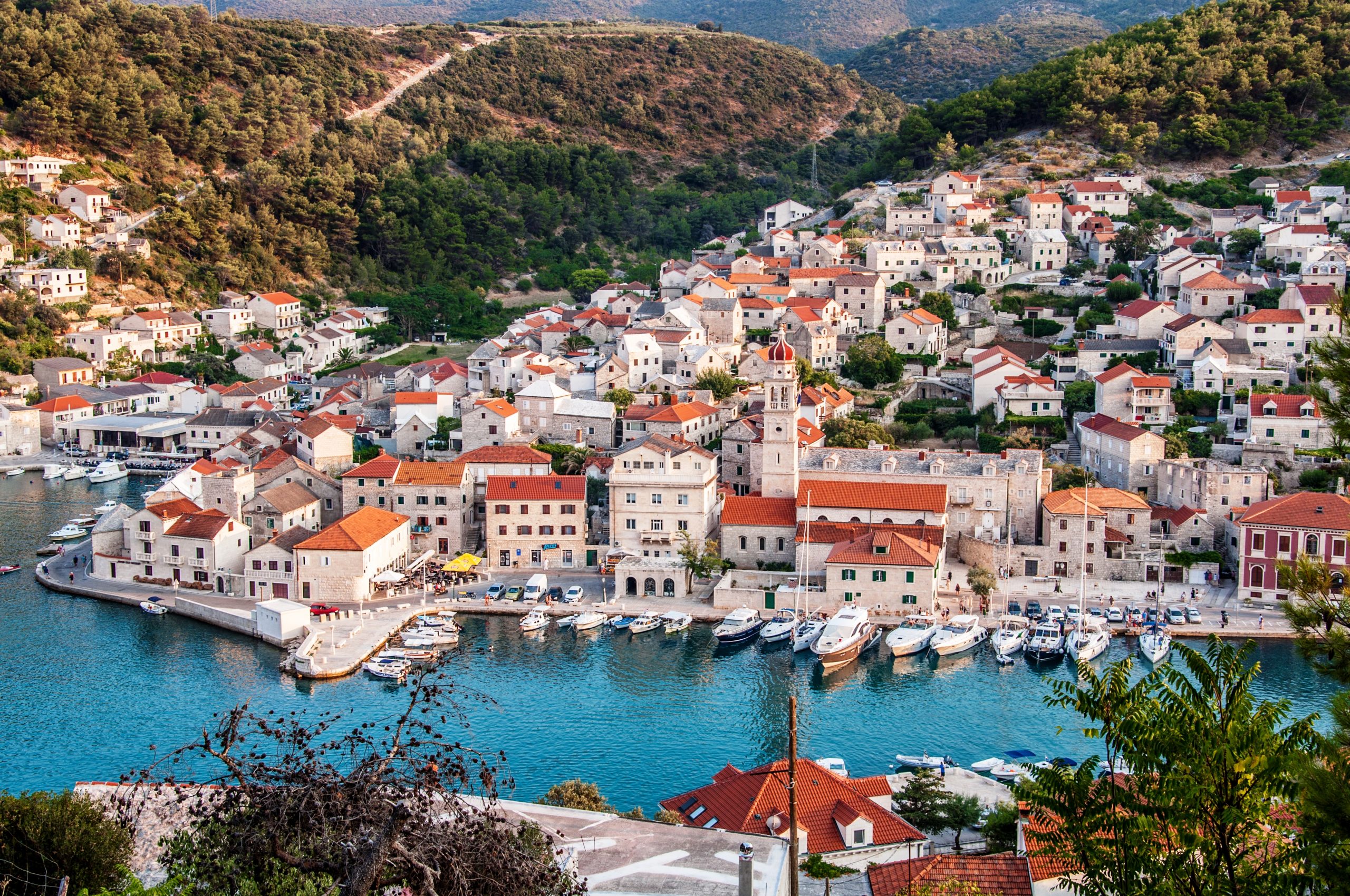


 Colleges and Universities in Europe
Colleges and Universities in Europe
 Nobel prize
Nobel prize
 University/Institute
University/Institute
 Nobel prize
Nobel prize
 Nobel Prize in Chemistry
Nobel Prize in Chemistry
 Sinology
Sinology

 Croatia
Croatia

 Sport
Sport
 (F)UEFA Europa League
(F)UEFA Europa League
 UEFA Champions League 2015/16
UEFA Champions League 2015/16
 UEFA Champions League 2016/17
UEFA Champions League 2016/17
 Group H
Group H
 UEFA Champions League 2019/20
UEFA Champions League 2019/20
 Group C
Group C
 UEFA Europa League 2018/19
UEFA Europa League 2018/19
 Group D
Group D

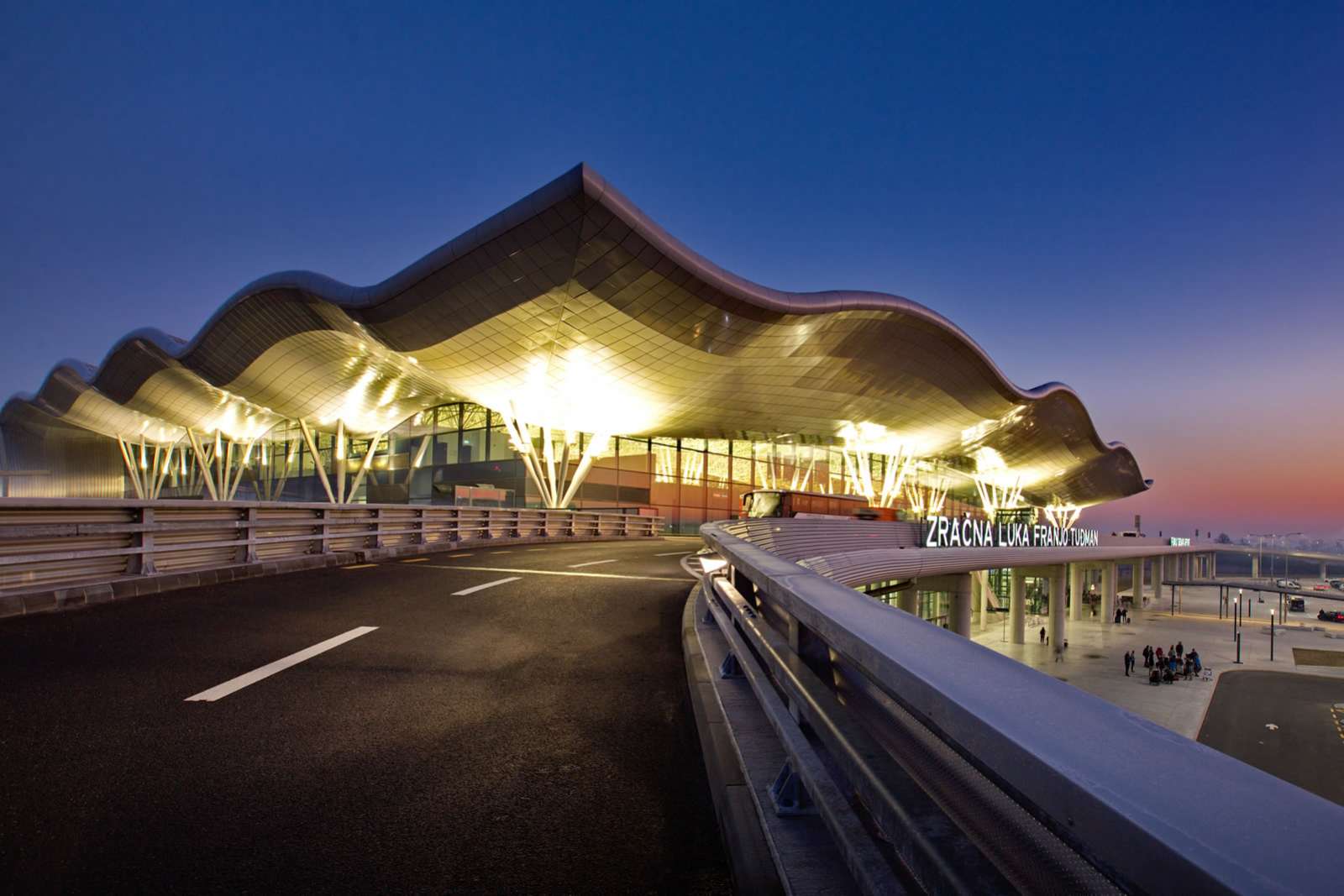

 Architecture
Architecture
 International cities
International cities
 History
History
 Music
Music
 Animal world
Animal world
 Geography
Geography


 Automobile
Automobile
 Exhibition
Exhibition
 Religion
Religion
 Transport and traffic
Transport and traffic


 Christmas Market
Christmas Market